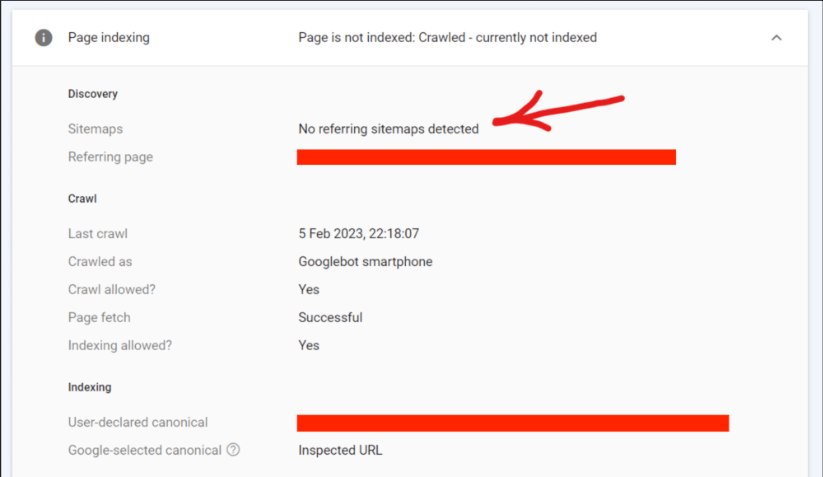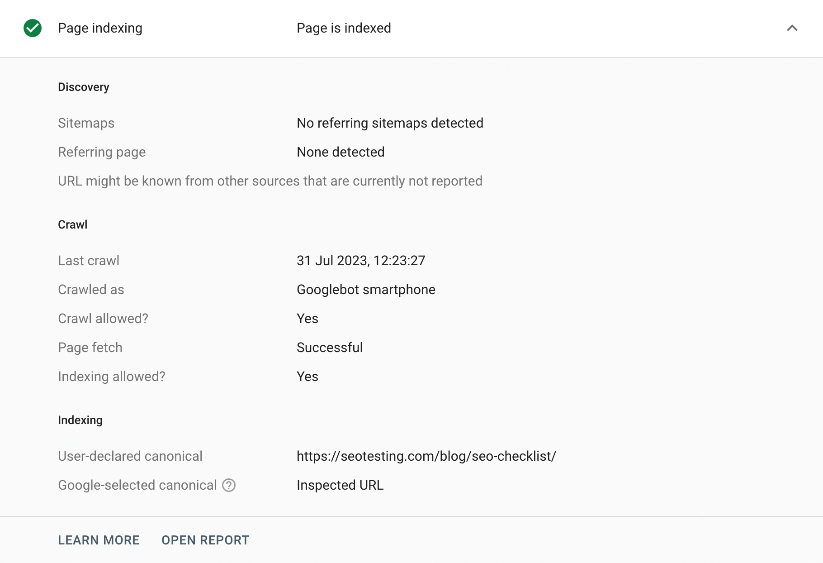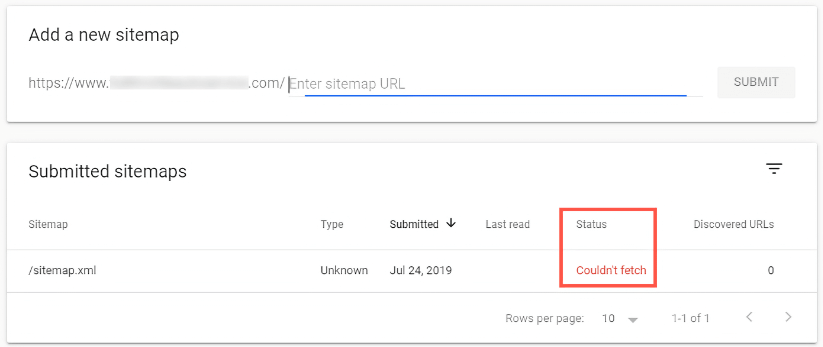When working on a website, whether it is your own or a client’s, you may come across the “No Referring Sitemaps Detected” issue in your Google Search Console Page Indexing report.
This is a common message in Google Search Console, but it can be concerning for first-time users or anyone who hasn’t encountered it before.
In this article, you’ll learn:
- What the “No Referring Sitemaps Detected” issue means
- Why it appears in Google Search Console
- How to fix or troubleshoot it
- How to properly submit a sitemap to Google
- Answers to the most common related questions
Quick Summary: No Referring Sitemaps Detected
- Meaning: Google displays the “No Referring Sitemaps Detected” message when a page isn’t listed in any XML sitemap submitted to Google Search Console.
- Common Reasons:
- The page is missing from the sitemap.
- The sitemap URL is incorrect or outdated.
- Google hasn’t refreshed sitemap data yet.
- How to Fix:
- Add the missing page to your sitemap and resubmit it in Google Search Console.
- Confirm the sitemap loads correctly at /sitemap.xml.
- Check for errors in the “Sitemaps” section of GSC.
- Why It Matters: Sitemaps help Google understand your site structure and discover important pages faster.
- Next Steps: If the page is already indexed and performing well, no action may be required. For non-indexed pages, adding them to your sitemap can improve indexing speed.
What is the ‘No Referring Sitemaps Detected’ Issue?
Essentially, Google displays the “No Referring Sitemaps Detected” message when it finds a page that is not listed in any XML sitemap submitted to Google Search Console.
This can happen for several reasons, including:
- The page was never added to your sitemap.
- The sitemap URL submitted to GSC does not include this page.
- The sitemap is outdated or not referencing new URLs.
Example: Non-indexed page showing the message:

Example: Indexed page showing the message:

It’s important to note that this is not necessarily an error. It’s more of a warning that Google couldn’t find this URL listed in your sitemap.
Your page can still rank and drive traffic even without a sitemap reference. However, properly referencing your URLs helps Google understand your site structure and crawl it more efficiently, which is why sitemaps matter.
How to Fix the Issue
The short answer: Add the missing page to your sitemap.
But the real answer is more nuanced. Here’s how to fix the “No Referring Sitemaps Detected” issue depending on the situation.
If your page is already indexed
- If it ranks well and brings in traffic, there’s no urgent need to act.
- You can add it to your sitemap for completeness, but it’s optional.
- Google already knows about it, even without a sitemap reference.
If your page is not indexed
If the page is not appearing in search results, add it to your sitemap immediately. This helps Google understand that the page is important and should be crawled again.
When you include a page in your sitemap, you are signaling to Google: “This page is high-quality and relevant — please index it.”
Example:

In this example, the page shows the Crawled – currently not indexed status. This means Google found the page but chose not to index it. Adding it to your sitemap can encourage Google to re-evaluate it.
If adding the page to your sitemap doesn’t resolve the issue, consider performing a content refresh to make it more valuable to users.
Why Sitemaps Matter
A sitemap helps Google and other search engines understand your website’s structure. It lists your most important URLs and shows how content connects across your site.
Key reasons sitemaps are important:
- They improve crawl efficiency.
- They help new content get discovered faster.
- They provide metadata about update frequency and priority.
If Google can’t detect your sitemap or certain URLs within it, it may take longer for new or updated pages to appear in search results.
‘No Referring Sitemaps Detected’ FAQs
What does ‘No Referring Sitemaps Detected’ mean?
This message means Google cannot find a reference to that page in your sitemap. It does not necessarily indicate a problem with your site’s performance or indexing.
Why can’t Google fetch my sitemap?
If you see a “Could not fetch” error in the Sitemaps section of Google Search Console, it means Google had trouble accessing your sitemap file.
Example:

Common reasons Google cannot fetch your sitemap include:
- Incorrect sitemap URL path (e.g., using /homepage or /index instead of /sitemap.xml).
- The sitemap file is corrupted or not properly formatted.
- Temporary server issues blocking Googlebot’s access.
How to fix this error:
- Check your sitemap URL in Google Search Console.
- Ensure the path ends with /sitemap.xml or your chosen sitemap filename.
- Validate the XML file in a browser to ensure it loads without errors.
- If it’s a large site, wait and try again. Sometimes Google retries and succeeds later.
How to properly submit a sitemap to Google
Submitting your sitemap correctly ensures Google can detect and reference it easily.
Steps to submit your sitemap:
- Go to Google Search Console.
- Select your website property.
- Open the Sitemaps section in the sidebar.
- Enter your sitemap URL (e.g., https://yourdomain.com/sitemap.xml).
- Click Submit.
After submission, monitor the status. If Google can’t fetch it, review the troubleshooting steps above.
Should I delete old sitemaps from Google Search Console?
You can delete old sitemaps from Google Search Console, but doing so will not stop Google from crawling or indexing URLs that were originally in those sitemaps.
If your goal is to prevent certain pages from being crawled, use noindex tags or remove the URLs from your sitemap file directly.
Next steps if no sitemap detected
If Google reports “No referring sitemaps detected” and you’ve confirmed your sitemap exists, follow these steps:
- Verify your sitemap URL is accessible and valid.
- Check that the specific page is included in the sitemap XML.
- Ensure the sitemap is submitted to Google Search Console.
- Use sitemap detection tools or online validators to confirm that Googlebot can access it.
If you’ve done all the above and still see the message, give Google time. Sometimes the message lags behind the latest crawl data.
Conclusion
The “No Referring Sitemaps Detected” issue in Google Search Console may seem worrying at first, but it’s often harmless.
We’ve covered:
- What this message means
- Why it appears
- How to fix it and properly submit your sitemap
- When to take further action
If you want to better understand your Google Search Console data and test SEO changes safely, try SEOTesting. It helps you identify what works, track performance, and grow organic traffic — with a free 14-day trial (no credit card required).


